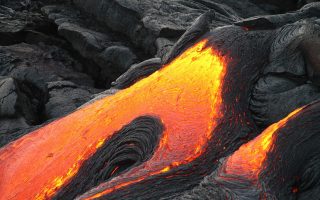
With the recent activity on Hawaii’s Kilauea volcano, several structures have been destroyed and many areas are now close to new volcanic vents. Geologists are even beginning to conclude that an explosive eruption at the volcano’s summit may be a possibility in the near future. However, Kilauea’s volcanic hazards don’t end with lava and the possibility of an explosive eruption. The same fissures from which lava is flowing are also emitting large quantities of volcanic gases, and an eruption at the summit would produce a huge cloud of ash and gases that would have significant implications for air quality on the island of Hawaii. Here’s what you need to know about the hazards of the Kilauea volcano that are related to gases and possible ash clouds.
What Kind of Gases Do Volcanoes Emit and How Do They Affect Human Health?
The gases produced by volcanic activity are often collectively known as vog, a combination of the words “volcanic” and “smog.” Vog is a result of the reaction of volcanic gases, particularly sulfur dioxide, with the oxygen and water in the atmosphere outside the volcano. This can result in a wide range of different compounds, but one of the most common is airborne sulfuric acid, as well as hydrogen sulfide. Symptoms of exposure to these chemicals can include nausea, headaches, disorientation and severe irritation of the eyes and throat. Although vog is always present on the island of Hawaii, the recent opening of new volcanic vents has brought this combination of noxious gases closer to populated areas. Shifting winds also have the potential to carry the large amounts of vog currently being produced across the island and into population centers.
What Harm Can Volcanic Ash Do?
Another one of Kilauea’s volcanic hazards that could have a detrimental effect on air quality is the ash that an explosive eruption would send into the atmosphere. Volcanic ash, made up of fine particles that are easily carried on the wind, can drift into residential areas and cause severe respiratory problems for those who inhale it. This type of particulate matter is especially hard on those who suffer from asthma, COPD and other chronic respiratory conditions.
Protecting Yourself from Kilauea’s Volcanic Hazards: Can an Air Purifier Help?
Given the very real existing threat of vog and the possibility of ash clouds in the event of a full-scale eruption, it’s obvious that residents of the affected parts of Hawaii need to take steps to protect themselves. A good starting point in keeping yourself safe under these conditions is to stay inside with the windows closed, which can help to protect you from some of the contaminants in the outside air. For better protection, however, an air purifier is a good choice. Following are a few of the home air purification units that we believe are best suited to reducing the risks associated with vog and ash exposure.
- Airpura V600: Covers up to 2,000 square feet and focuses on VOCs and specific airborne chemicals. Free 2-day air shipping to Hawaii.
- Airpura C600DLX: A step up from the V600, the Airpura C600DLX is an excellent option for dealing with vog on account of its focus on sulfur-based chemical compounds. Free 2-day air shipping to Hawaii.
- Airpura P600: With a filter boasting a full 18 pounds of activated carbon, the Airpura P600 is one of the higher-end options for removing dangerous gases from the air. This unit cleanses areas of up to 2,000 square feet and achieves a full two air changes per hour, making it capable of removing more gases. In addition, this purifier features a true HEPA filter with 40 square feet of overall surface area.
In addition to these larger units, it can also be a good idea to use smaller air purifiers in specific rooms for extra protection. A small unit, such as the Amaircare 2500, should be used in your bedroom to further protect you from gases emitted by the volcano. Using multiple air purifiers in your home for cross-filtration is a good way to optimize the quality of your indoor air, especially when you’re dealing with a source of contamination as major as gases from a volcano.
For the best possible protection, we recommend running your air purifier on a high setting for about an hour when you first plug it in, then switching to a medium or low setting and running it 24/7 from then on. The initial high setting will help to quickly clean out gases that have accumulated in your house, after which the unit can be switched to a lower setting for air quality maintenance.
By taking these steps, you can help to keep the air you’re breathing, despite the gases being emitted by Kilauea. If you have any questions about protecting yourself from Kilauea’s volcanic hazards as they relate to air quality, feel free to contact us, and we’ll be happy to help you pick out the right air purification systems for your needs.